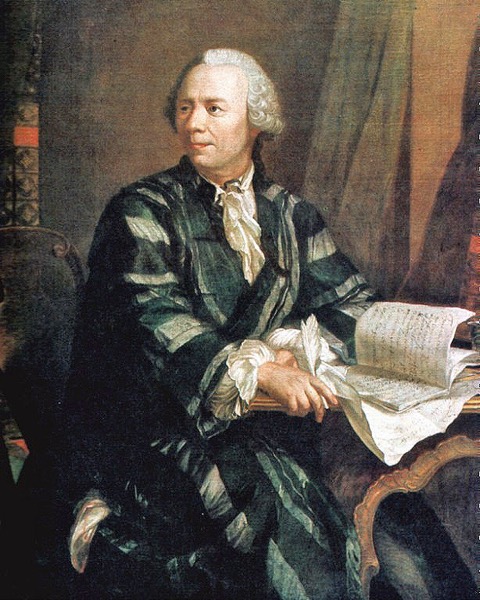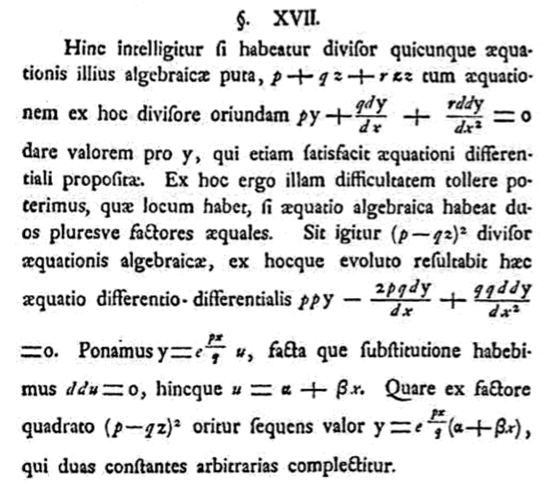- About MAA
- Membership
- MAA Publications
- Periodicals
- Blogs
- MAA Book Series
- MAA Press (an imprint of the AMS)
- MAA Notes
- MAA Reviews
- Mathematical Communication
- Information for Libraries
- Author Resources
- Advertise with MAA
- Meetings
- Competitions
- Programs
- Communities
- MAA Sections
- SIGMAA
- MAA Connect
- Students
- MAA Awards
- Awards Booklets
- Writing Awards
- Teaching Awards
- Service Awards
- Research Awards
- Lecture Awards
- Putnam Competition Individual and Team Winners
- D. E. Shaw Group AMC 8 Awards & Certificates
- Maryam Mirzakhani AMC 10 A Awards & Certificates
- Two Sigma AMC 10 B Awards & Certificates
- Jane Street AMC 12 A Awards & Certificates
- Akamai AMC 12 B Awards & Certificates
- High School Teachers
- News
You are here
D'Alembert, Lagrange, and Reduction of Order - Enter Euler
 |
|
Leonhard Euler (1707-1783) |
Whenever recovering mathematics from the 1700s, it is always prudent to check the work of Leonhard Euler to make sure he didn't do it earlier or better. Indeed when looking at Euler's contributions to the study of linear differential equations, one can find the techniques of both d'Alembert and Lagrange. First, in 1743, Euler published “De integratione aequationum differentialium altiorum graduum” (“On the integration of differential equations of various degrees”) [5, p. 193]. He described how to solve higher order linear differential equations with constant coefficients
\[0=Ay + \frac{B dy}{dx} + \frac{C ddy}{dx^2}+ \frac{Dd^3y}{dx^3} + \frac{E d^4 y}{dx^4} + \&c.\]
Euler assumed the solution was of the form \(e^{zx}\) and substituted into this differential equation, giving an algebraic auxiliary equation
\[0=A+Bz+Cz^2+Dz^3+Ez^4+ \&c.\]
If \((pz-q\)) is a factor of this equation, then \(e^{\frac{qx}{p}}\) is a solution to the differential equation. Euler was aware of this as far back as 1739 when he and Johann Bernoulli corresponded on these equations [7, p. 448]. His 1743 paper also answers what happens when \((pz-q)\) is a repeated factor. If \((pz-q)^2\) is a factor of the auxiliary equation, then Euler let \(y=e^{\frac{px}{q}} u\) where \(e^{\frac{px}{q}}\) is the known solution and \(u\) is an unknown function. He proceeded to show that \(u=\alpha + \beta x\), which gave him the second solution to the equation. Later in this paper he studied equations with higher order repeated factors as well as those with complex roots.

Figure 8. Euler used d'Alembert's technique in 1743 to deal with repeated roots of the auxiliary equation [5, p. 204].
This seems to turn the tables on the typical relationship between Euler and d'Alembert (see the Appendix). This time Euler earned priority, but d'Alembert presented the material in greater generality and with more clarity.
Morris Kline, in his Mathematical Thought from Ancient to Modern Times, mentioned that Euler also utilized Lagrange's method, though well after Lagrange published it in 1766. He wrote [10, p. 487]:
Hence Lagrange discovered the theorem that the adjoint of the adjoint of the original non-homogeneous ordinary differential equation is the original but homogeneous equation. Euler did essentially the same thing in 1778. He had seen Lagrange's work, but apparently forgot about it.
It appears Kline was referring to Euler’s paper “Observatio singularis circa aequationes differentiales lineares” (“Special observations about linear differential equations”), a paper written in 1778, but published years later in 1805 [6, p. 42].
Sarah Cummings (Wittenberg University) and Adam E. Parker (Wittenberg University), "D'Alembert, Lagrange, and Reduction of Order - Enter Euler," Convergence (September 2015)




